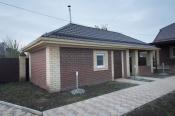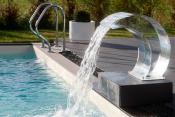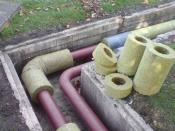Search
Login
Recommended
DIY plastic garden paths
Currently, in order to improve the garden path, there is no need to purchase expensive materials, because plastic tile or modules that are several times cheaper, such as clinker bricks or pavers, can easily cope with this task. In addition, the aesthetic appeal of modern plastic is suitable for almost any exterior. At the same time, even a schoolboy may well collect a track from plastic modules, since special knowledge is not required here.
Content
Types of tracks made of plastic, their characteristics
In the process of manufacturing plastic, various kinds of polymers, additives, fillers are used that determine the operational characteristics of the material obtained and the area of \u200b\u200bits purpose. Therefore, based on the main component, all plastics are divided into groups such as polyethylene, polyvinyl chloride, polypropylene, etc.
Plastic elements used for arranging garden paths are made from various compositions, therefore they are divided into the following types:
1. Modules made of high strength polyethylene are better known as weed. In this case, the color scheme of this category of coating can be black, blue, burgundy and other shades.

Benefits:
- Prevents slipping in the winter and rainy summer day;
- Good drainage properties;
- Speed \u200b\u200bof assembly, disassembly;
- Mobility of the assembled structure;
- Ease of replacing a damaged module;
- Low cost.
Disadvantages:
- After a short operational period, the grass bristles will break due to the relative strength of the material;
- Long-term use affects the modification of the original color;
- Short life.
2. Modules based on the production of polypropylene of special grades are represented by square shapes in the form of:
- Closed tiles with small perforated holes;
- Lattices with cells of various configurations. In this case, the cells on the front side of the element can be either open type or partially closed by a pattern.
Compared to the previous type, polypropylene modules have higher hardness and impact resistance. However, along with polyethylene modules, they easily undergo mechanical destruction at temperatures exceeding -25 C.
Benefits:
- Withstand temperature fluctuations in the range from -20 to +40 C;
- High wear resistance;
- Drainage holes prevent the formation of puddles;
- Chemical, biological resistance;
- A wide range of shapes and colors;
- Quick installation without the use of auxiliary materials;
- Simplicity of dismantle of a design;
- Ease of replacing a damaged element without dismantling the entire coating;
- Light weight;
- Low cost.
Disadvantages:
- Over time, a change in the initial shade due to exposure to ultraviolet radiation is possible;
- The presence of a perfectly flat surface for installation;
- Severe frosts combined with mechanical stress on the module can cause its destruction;
- Fragility.
3. A tile made from a polymer-sand mixture differs from the previous types in the uniformity of the structure, closed by the front surface with or without an extruded pattern. In addition, the properties of polymer-sand tiles significantly outperform other types of plastic modules.

Benefits:
- Accuracy of geometric dimensions;
- Environmentally friendly material that prevents the release of harmful substances on hot days;
- Zero water absorption;
- The surface roughness prevents slipping in rainy and frosty weather;
- High degree of wear resistance;
- High degree of impact resistance;
- UV resistance due to the use of mineral dyes;
- Resistance to sharp temperature fluctuations within -50 to +70 C;
- When cutting, dust, chips, or cracks do not form;
- The elasticity of the material, preventing the deformation of the tile during transportation;
- Excellent resistance to aggressive environments;
- Not susceptible to corrosion;
- Lightness of individual elements;
- Long term of operation.
Disadvantages:
- High price.
Thus, the use of modules allows you to assemble any size garden path from plastic, the price of which depends on the type of material used to manufacture these modules.
Installation of a plastic track
Different types of garden paths made of plastic differ, in addition, in the way of installation.
modular coatings made of polyethylene and polypropylene
Despite the different composition and properties of these types of plastic, the requirements for preparing the base for their installation are the same, as is the assembly of individual modules in a single piece.
If the place for the track has a fairly flat surface, allowing minor bumps up to 0.5 cm, then additional preparation of the base is not required. Otherwise, it is necessary to level the surface by completely removing the top layer of turf, or by removing only convex sections. At the same time, to avoid the germination of grass through the drainage holes, the base of the path must be covered with a black film.
The grass assembly from plastic is assembled by means of snap-on connectors located around the perimeter of the modules, which make it possible to construct not only a straight track, but also a winding one.

Using modules of various shades, it is quite possible to create a simple pattern, giving the path additional attractiveness.
polymer sand tiles
Unlike previous types of plastic, polymer-sand tiles require a more thorough preparation of the base and a more complex laying process, including the following:
- Marking the future track;
- A trench digs to a depth of 30-40 cm with a slight bevel to drain water from the path;
- The bottom of the groove is covered with geotextile, and on top with a layer of crushed stone, comprising 10-15 cm, and rammed;
- A layer of 5-10 cm of sand is poured over the rubble, which is carefully leveled, moistened and compacted;
- Tiles are laid on the compacted layer of sand, and each tile must be tamped into the sand with a rubber hammer, not forgetting to leave gaps between the tiles of 3-5 mm;
- At the end of the installation, the seams between the tiles are woken up with sand, moistened and again poured with sand to the upper edge of the tile.
For a more reliable installation, if the track will be used to drive a car along it, the sand layer is covered with a cement screed, after drying of which the tile is installed using specially selected glue.
After completing the laying of the main track, you can proceed to the installation of borders. To do this, trenches are dug along the edges of the path to the required depth, the bottom of which is covered with sand with a layer of 5 cm, after which curb stones are installed and the grooves are covered with soil.
Thus, depending on the desired result, it is possible to purchase paths for giving from plastic at various financial cost, term of operation and complexity of installation. At the same time, plastic tracks will look just as good as any expensive material.





